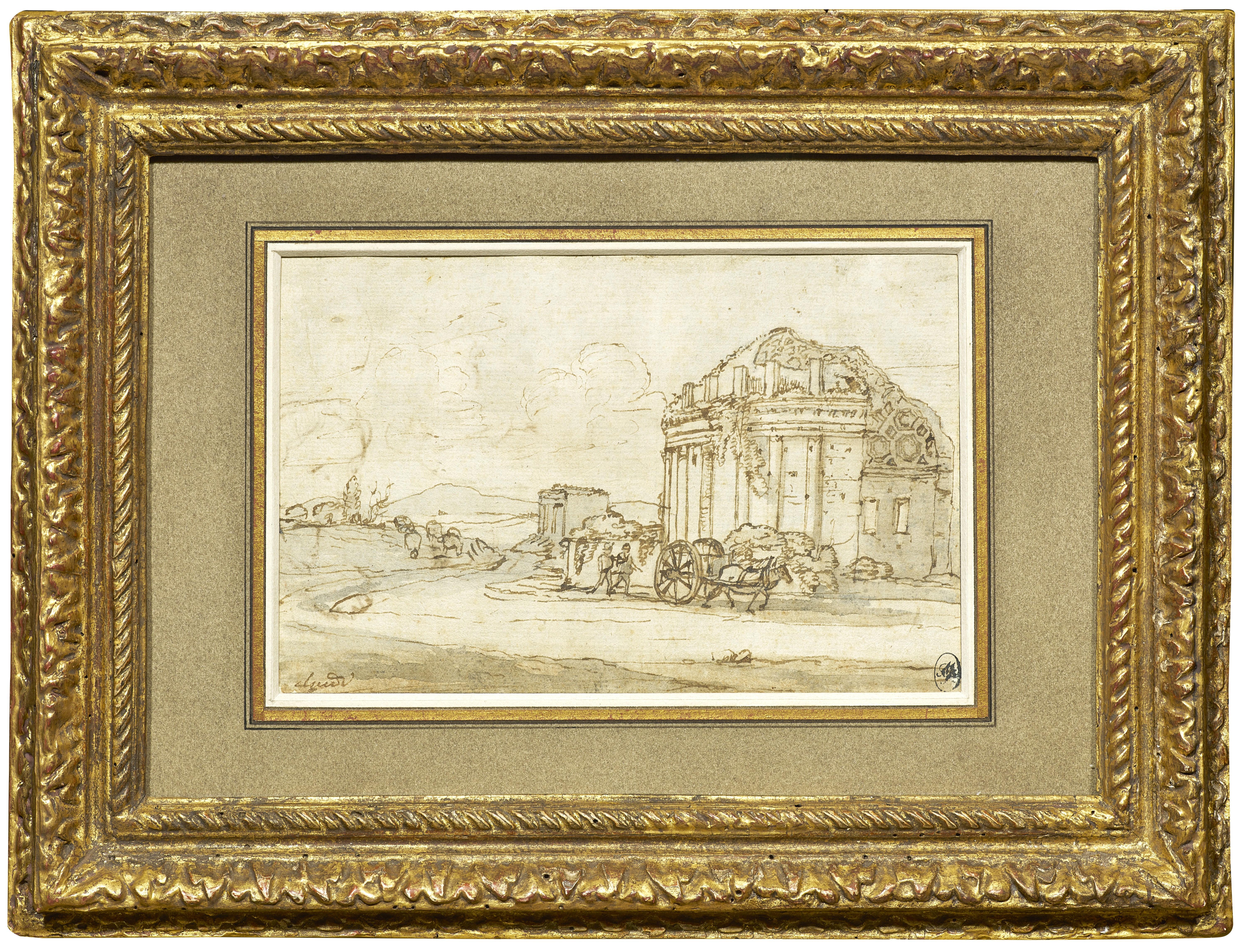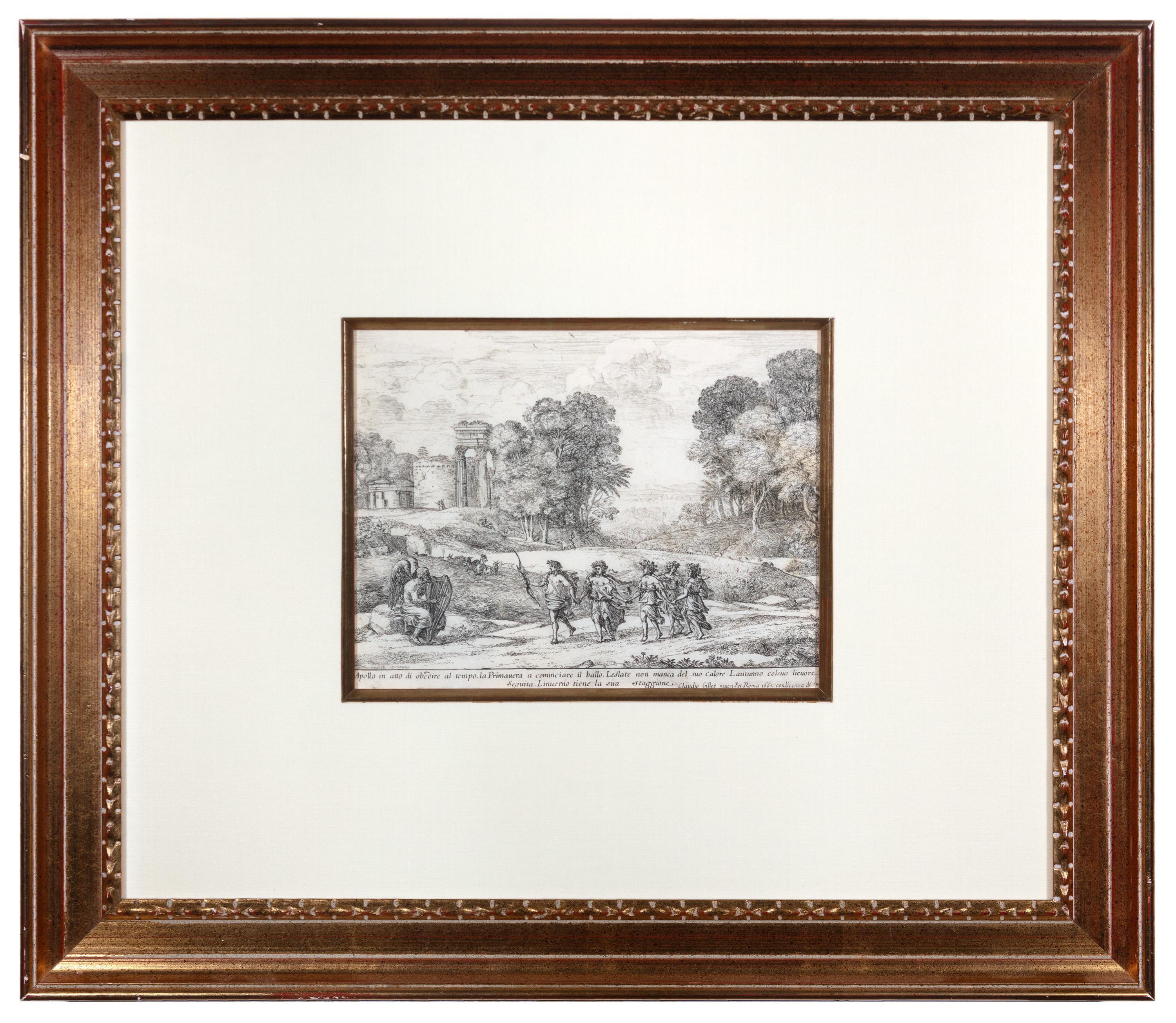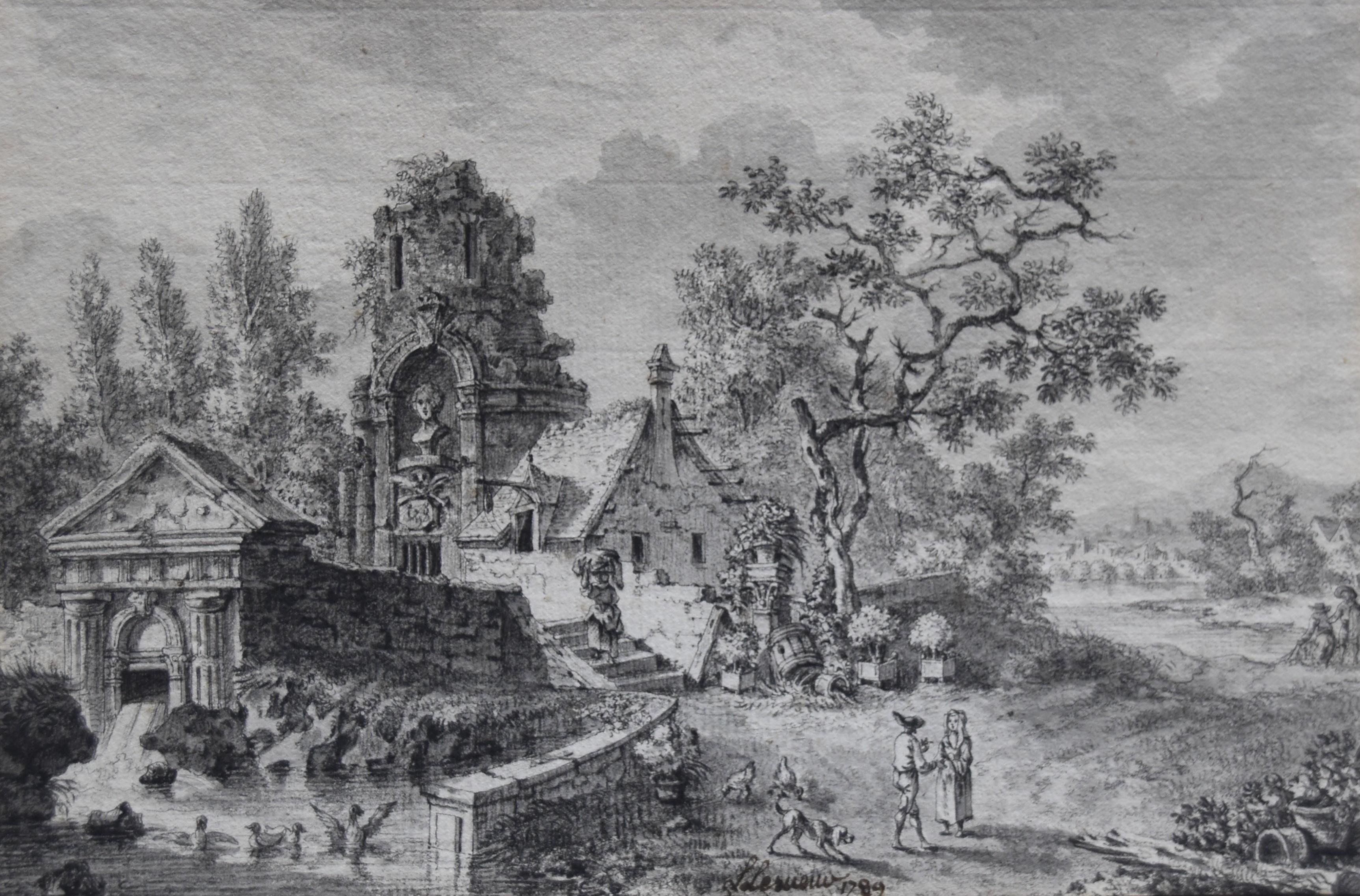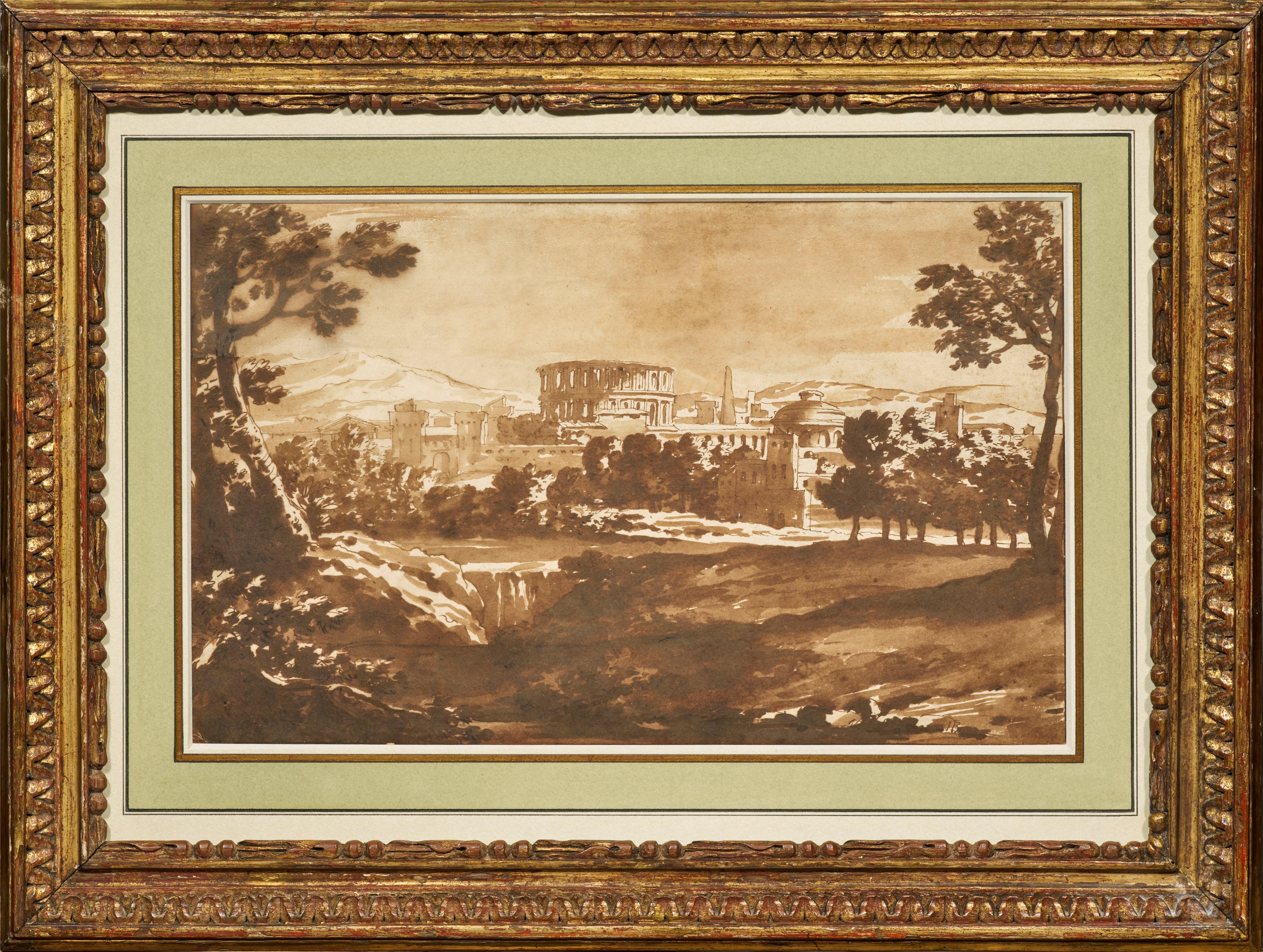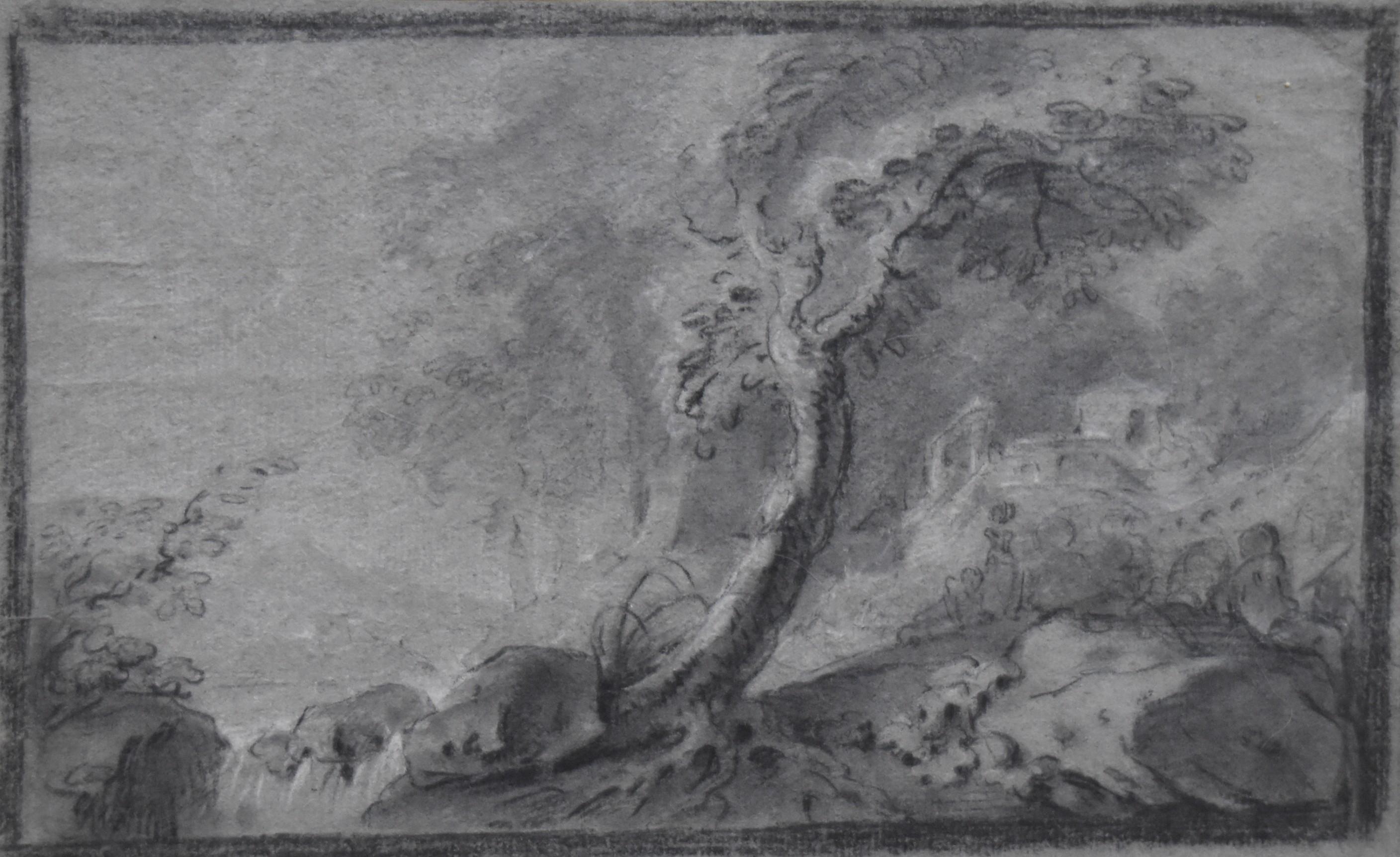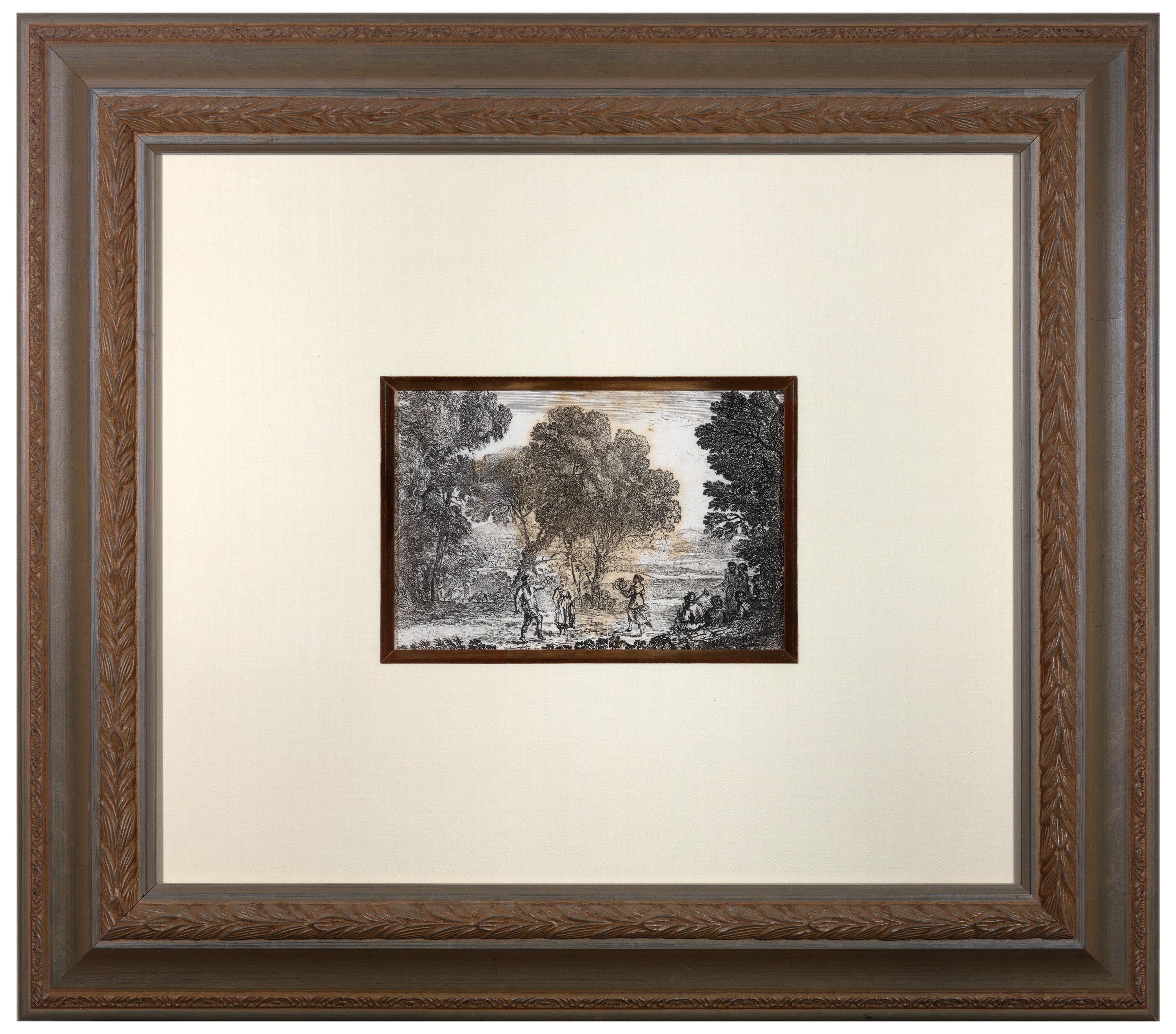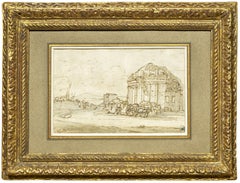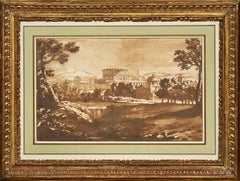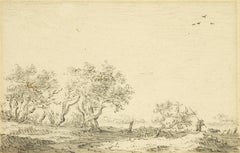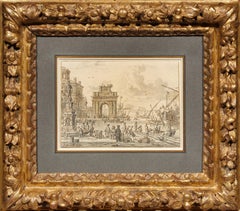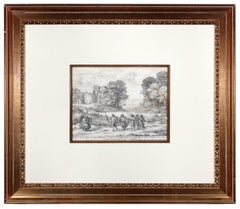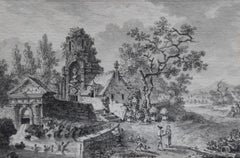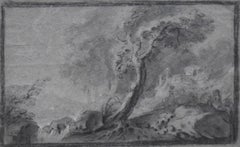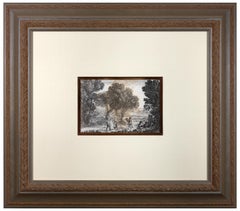Items Similar to Rocky Landscape with Trees and Temple Ruins a drawing by Giulio Parigi (ca 1615)
Want more images or videos?
Request additional images or videos from the seller
1 of 11
Giulio ParigiRocky Landscape with Trees and Temple Ruins a drawing by Giulio Parigi (ca 1615)1615
1615
$8,394.25
£6,244.48
€7,000
CA$11,494.60
A$12,780.43
CHF 6,673.24
MX$155,569
NOK 85,147.60
SEK 79,779.24
DKK 53,287.13
Shipping
Retrieving quote...The 1stDibs Promise:
Authenticity Guarantee,
Money-Back Guarantee,
24-Hour Cancellation
About the Item
This Rocky Landscape with Trees and the Ruins of a Temple is a drawing by Giulio Parigi, an eclectic and prolific artist of the Medici court. An engraver, architect, furniture and jewelry designer and scenographer, he was also the master of a renowned academy, where he taught mechanics, perspective, architecture, and landscape painting.
This drawing is a new addition to the artist's catalog. It demonstrates the extraordinary temperament of this artist, who offers us here an original synthesis between scenic fantasy and the influence of the imaginary world created by Nordic artists, freely inspired by the real landscape of Tivoli.
1. Giulio Parigi, a multi-talented artist at the heart of the artistic life of his time
Giulio Parigi was born in Florence on April 6, 1571. He was the son of Alfonso di Santi Parigi, originally from Prato, and Alessandra di Berto Fiammeri. Trained by his architect father and great-uncle Bartolomeo Ammannati, he was quickly integrated into the artistic milieu of the court, working from an early age under the direction of Bernardo Buontalenti, with whom he later collaborated as decorator and draftsman. In 1594, he enrolled at the Academy of Drawing as a "painter"; in 1597, he was pensioned by the Grand Ducal Court.
From 1613, Giulio Parigi worked intensively as a civil engineer for the Grand Duke, which led him to Rome in 1616. On his return to Florence, Parigi won the competition launched by Cosimo II for the enlargement of the Pitti palace; he began by building the "Grotticina di Vulcano" in the Boboli gardens (1617) and laid the foundation stone for the palace's north wing on May 29, 1620. Parigi remained in charge of the works until 1633, when he was succeeded by his son Alfonso, who continued the enlargement according to his father's instructions.
In the graphic output of Giulio Parigi and the engravers of his entourage, we find many illustrations of festivities and theatrical performances at the Medici court, testifying to the pre-eminence of the court over Florentine public life. As an architect and a scenographer, an engraver and a draughtsman, Giulio Parigi is one of the most convincing examples of the relationship between these ephemeral creations linked to the theater or grand festivities and the Mannerist language, strongly influenced by the Nordic currents present in the artistic culture of grand-ducal Florence.
With the formation of the famous Accademia, Giulio Parigi gathered around him a large number of pupils: in addition to Jacques Callot (a landscape painter and engraver), we can cite his sons Alfonso (an architect, engineer, scenographer and engraver) and Andrea (an engineer, excellent landscape painter and skilful inventor of fireworks), Antonio Cantagallina (a master of perspective), and his brother Giovan Francesco (a landscape painter and master of fortifications), and artists such as Giovanni da S. Giovanni and, for a time, Stefano della Bella, Baccio del Bianco or Agostino Tassi.
Giulio died in Florence on July 13, 1635, and was buried in the chapel of the church of S. Felice in Piazza, which he had designed.
2. Subject and identification of our drawing
The well-preserved sheet shows a forest of trees with complex, gnarled trunks, whose sparse foliage is evoked by oblique and parallel hatching. The ground is studded with boulders, also shaped by hatching. The composition is closed on the left by a rocky entablature running along the edge. This scenographic expedient is characteristic of stage decors intended for theatrical performances. On the right a trunk curves out, with a typically Nordic physiognomy.
The space is skilfully structured in several planes: from the first, set in a contrasting chiaroscuro, we pass to a luminous clearing, beyond which rise rocky mounds with sharp profiles, drawn with a single stroke of the pen in brown ink, which punctuate the landscape and give a vibrant sense of movement. Above the rocks rise the ruins of an ancient temple, whose six columns in the cella indicate its original round shape.
This temple is loosely based on that of the Sibyl (or Vesta) at Tivoli, situated above the rocky spur adjoining the ancient acropolis of Tibur overlooking the vast Aniene valley. The Flemish artists Paul Bril (1554-1626) and Jan Brueghel the Elder (1568-1625) were the first to be fascinated by the power and mystery of this place, where the natural elements, impetuous and picturesque, freely blend into the landscape.
In the clearing in lower right foreground, with fine, angular calligraphy executed with a pen, the author leaves the following inscription: "Di Flaminio Giuletto/ Venari Saturn [ale?]". While the second part, difficult to decipher, could refer to a theatrical performance (perhaps executed at the time of the winter festivities known as Saturnalia?), the first part is a clear reference to Giulio's northern style of depicting landscapes, which, by distinguishing him from his Florentine contemporaries, had earned him the nickname "Flemish".
In all likelihood, our sheet was executed, probably around 1615, during a session at the Accademia, as a test of skill on a naturalist theme that adhered to the taste for fantasy transposed into the real world in using a modern artistic language, inspired by Nordic painters. It is possible that this drawing was intended for engraving, as evidenced by the parallel hatching of the cloud-sprinkled sky.
Our drawing can be compared with two others by the artist in the Uffizi : the Tuscan Landscape (P. 220), and the Landscape with a Farm (P170).
3. Framing
Our drawing comes in a cherrywood frame with a highly original pinecone scale decoration. Dating from the early 19th century, it probably originates from northern Italy.
- Creator:Giulio Parigi (1571 - 1635, Italian)
- Creation Year:1615
- Dimensions:Height: 15.38 in (39.07 cm)Width: 19.5 in (49.53 cm)
- Medium:
- Movement & Style:
- Period:
- Condition:Dimensions : 7’’ x 11 3/4" (177 x 297 mm) - Framed: 15 3/8’’ x 19 ½’’ (39 x 49.5 cm) We would like to thank Carolina Trupiano Kowalczyk for confirming the attribution of this drawing to Giulio Parigi after direct examination of the artwork.
- Gallery Location:PARIS, FR
- Reference Number:1stDibs: LU1568216220682
About the Seller
5.0
Vetted Professional Seller
Every seller passes strict standards for authenticity and reliability
Established in 2020
1stDibs seller since 2021
10 sales on 1stDibs
Typical response time: 2 hours
- ShippingRetrieving quote...Shipping from: PARIS, France
- Return Policy
Authenticity Guarantee
In the unlikely event there’s an issue with an item’s authenticity, contact us within 1 year for a full refund. DetailsMoney-Back Guarantee
If your item is not as described, is damaged in transit, or does not arrive, contact us within 7 days for a full refund. Details24-Hour Cancellation
You have a 24-hour grace period in which to reconsider your purchase, with no questions asked.Vetted Professional Sellers
Our world-class sellers must adhere to strict standards for service and quality, maintaining the integrity of our listings.Price-Match Guarantee
If you find that a seller listed the same item for a lower price elsewhere, we’ll match it.Trusted Global Delivery
Our best-in-class carrier network provides specialized shipping options worldwide, including custom delivery.More From This Seller
View AllA landscape drawing by Claude Lorrain, with a preliminary sketch on the verso
By Claude Lorrain
Located in PARIS, FR
This study presents a typical Roman countryside landscape: an ancient mausoleum in front of which a cart is passing by followed by two peasants. If the technique (a pen drawing on graphite lines, completed with a wash of brown and grey inks) and the signature inevitably evoke the art of Lorrain, we find on the verso of this drawing additional evidences that lead us to consider this unpublished drawing as a work by the master.
The motif of the mausoleum has been taken up in pen on the verso in a technique that can be found in several other drawings by Lorrain. There is also a study of three characters, which can be considered as preparatory to Lorrain’s painting entitled The Port of Ostia with the Embarkation of Saint Paula, leading us to claim this attribution with a dating of around 1639.
1. Claude Lorrain or the perfection of classical landscape in Rome in the 17th century
Claude Gellée was born in 1600 in Chamagne in Lorraine. Orphaned at the age of twelve, he spent a year with his brother in Freiburg, where the latter was a woodcarver. Claude Gellée then probably arrived in Rome in 1613, where he joined the workshop of Agostino Tassi (1580 - 1644) in 1617. Between 1619 and 1620 he studied for two years in Naples in the workshop of Goffredi Wals (who was himself a former pupil of Tassi).
In 1625 he returned to Lorraine for two years where he worked alongside Claude Deruet. He then returned to Rome, a city he never left for the rest of his life (except for short trips to the surrounding countryside).
From 1627 to 1650 he lived in Via Margutta. From 1635 onwards he became a renowned painter and commissions started to pour in. Considered during his lifetime as the most accomplished of the classical landscape painters, his reputation never faded.
Between 1629 and 1635 Le Lorrain often went to the Roman countryside to draw with his friend Joachim von Sandrart (1606 - 1686). He became a member of the Academy of Saint Luke in 1633, while being closely acquainted with the Bentvueghels, this guild which brought together the young Nordic painters active in Rome. In 1643 he joined the Congregation of the Virtuosi. In 1650 he moved to Via Paolina where he lived until his death.
Little is known of his intimate life. He seems to have had a daughter, Agnes, from an ancillary love affair. In 1657/ 1658 she moved in with him. Stricken with gout in 1663, he died in 1682.
2. Description of the drawing; the technique of nature studies
Two peasants are walking behind a horse-drawn cart on a road that winds through ancient tombs. While a rectangular tomb with a columned facade can be seen in the distance, the cart passes an important ancient building. It has a circular shape and its partially ruined façade is decorated with columns. The start of a second floor can...
Category
1630s Old Masters Landscape Drawings and Watercolors
Materials
Pen, Graphite, Ink
View of an Antique City, a wash landscape by Jan de Bisschop (1628 - 1671)
Located in PARIS, FR
The attribution to Jan de Bisschop has been confirmed by the RKD with the following comment: "We base this attribution on the dark washes, the subject represented and the monogram".
...
Category
17th Century Old Masters Landscape Drawings and Watercolors
Materials
Ink, Pen
Landscape with Trees and a Fisherman walking, a drawing by Jan Van Goyen
By Jan Josefsz Van Goyen
Located in PARIS, FR
No Dutch draughtsman ever captured the atmosphere of the rural countryside of Holland with the same atmospheric and engaging simplicity that Van Goyen achieved in drawings such as this. Indeed, his landscapes were seminal in the development of the genre. The present sketch conveys a striking sense of movement within the natural landscape, conveyed by the deftly applied strokes of chalk, from which the artist’s hand can be sensed. The composition is characteristic of his work, with the low horizon affording significance to the broad sky and the soaring birds within. This feeling of windswept motion powerfully evokes the expansive Dutch farmland with which he was evidently preoccupied.
1. Jan van Goyen...
Category
1650s Old Masters Landscape Drawings and Watercolors
Materials
Chalk, Ink, Laid Paper
Imaginary View of an Italian Port, a signed and dated drawing by Jacobus Storck
Located in PARIS, FR
In this finely executed pen and wash drawing, Jacobus Storck presents us with an imaginary view in an Italian port. The splendor of the buildings (the large sculpted fountain surmoun...
Category
1680s Old Masters Landscape Drawings and Watercolors
Materials
Paper, Pencil, Pen, Ink
Italian Landscape with Jack Players, a painting by Gaspard Dughet (1615 - 1675)
By Gaspard Dughet
Located in PARIS, FR
Here Gaspard Dughet offers us an idyllic vision of the Roman countryside. The stages follow one another in a perfectly structured composition, revealing here a lake, there travellers walking along, gradually leading our eye to the blue horizon. But behind its classical composition, this landscape is particularly interesting because of three anthropomorphic details that the artist has hidden, opening the way to a radically different interpretation...
1. Gaspard Dughet, a landscape artist in the light of Poussin
Gaspard Dughet was born on June 4th, 1615 in Rome where his father, of French origin, was a pastry cook. He was probably named Gaspard in honour of his godfather Baron Gaspard de Morant, who was, or may have been, his father's employer. His older sister Jeanne married the painter Nicolas Poussin (1594 - 1655) on September 1st, 1630. The young Gaspard was apprenticed with his brother-in-law at the beginning of 1631, which led his entourage to name him Gaspard Poussin. The first preserved works of the painter date from the years 1633-1634 and were painted in Poussin’s studio.
Around 1635, Gaspard Dughet became emancipated and began to frequent the Bamboccianti circle. In 1636, he became friends with the painter Jean Miel (1599 - 1656), but also with Pier Francesco Mola (1612 - 1666) and Pietro da Cortona (1596 - 1669).
This was also the time of his first trips throughout Italy. The painter, although of French origin, appears never to have visited France. In 1646 he settled permanently in Rome. A recognized painter with a solid book of orders, he remained faithful to landscape painting throughout his life, alternating between cabinet paintings and large decorative commissions, using both oil and fresco.
Nailed to his bed by rheumatic fever at the age of 58, he died on May 25, 1675.
2. Discovering an idealized landscape
Beyond a relatively dark foreground that takes us into the landscape, we discover a vast bluish horizon: a plateau surrounded by deep ravines advances to the right, overhanging an expanse of water that sparkles below. A road winds through a mountainous mass as if leading us to the fortress that crowns it; another town appears in the distance at the foot of three conical mountains.
The composition is rigorous, mineral, and structured by geometric volumes. The various stages in the landscape lead one to the next attracting the eye towards the horizon located in the middle of the canvas. The general impression is that of a welcoming and serene nature.
In many places the paint layer has shrunk, or become transparent, revealing the dark red preparation with which the canvas was covered and accentuating the contrasts.
Human presence is limited to three jack players, leaning against a mound in the foreground. Their long garments, which may evoke Roman togas, contribute to the timelessness of the scene.
Close examination of the canvas reveals two other travellers on the path winding between the rocks. Made tiny by the distance, their introduction in the middle register, typical of Dughet's art, lengthens the perspective.
While it is difficult to date the work of a painter who devoted his entire life to the representation of landscapes, it is certain that this painting is a work from his later years. The trees that occupied the foreground of his youthful compositions have been relegated to the sides, a stretch of water separates us from the arid mountains counterbalanced by two trees represented on the opposite bank. The introduction of this stretch of water in the middle of the landscape betrays the influence of the Bolognese and in particular of the Dominiquin (1581 - 1641)
A number of similarities with a drawing in the British Museum might suggest a date around 1656-1657, since, according to Marie-Nicole Boisclair , it has been compared with the Prado's Landscape with the Repentant Magdalene, painted at that period.
3. Three amazing anthropomorphic details
While some late Renaissance landscapes offer a radical double reading, allowing one to see both a face or a human body behind the representation of a landscape, it seems interesting to us to hypothesize that Gaspard Dughet had fun here by slipping in a few details that, taken in isolation, evoke human or animal figures.
We will give three examples, looking closely at a cloud, the trunk of a broken tree and the top of a cliff.
The main cloud could thus evoke a Christ-like face or that of an antique god...
Category
1650s Old Masters Landscape Paintings
Materials
Oil
View of a Mansion in the South of France, a drawing by Claude-Joseph Vernet
By Claude-Joseph Vernet
Located in PARIS, FR
We would like to thank Madame Beck-Saiello for confirming the autograph nature of this drawing after an in-person examination.
It was probably during an excursion in the countryside near Avignon that Claude-Joseph Vernet executed this drawing, enhanced with pen and brown ink, depicting a mansion on a hilltop overlooking a small village with geometric shapes.
1. Joseph Vernet, a painter influenced by Italy
Claude-Joseph Vernet was born in Avignon in 1714, the son of Antoine Vernet (1689-1753), an artisan painter of architectural decorations, coach panels, and the like. He moved to the studio of Philippe Sauvan (1697-1792), a leading history painter in Avignon, and then worked with Jacques Viali (active 1681-1745), a decorative, landscape, and marine painter in Aix-en-Provence. Vernet's first recorded paintings were decorative overdoors executed in 1731 in the Aix townhouse of the marquise de Simiane. In 1734, Joseph de Seytres, marquis de Caumont, a leading amateur in Avignon, sponsored Vernet to make a study trip to Italy to complete his artistic education and to draw antiquities for his patron.
As Avignon was a papal territory in Vernet's day, he also had a number of useful introductions among influential churchmen when he arrived in Rome. Vernet was soon at home in the French community there, and he was encouraged by Nicolas Vleughels (1668-1737), director of the Académie de France in Rome, even though the young painter had no official affiliation with the royal institution. He likely entered the studio of the French marine painter Adrien Manglard...
Category
1730s Old Masters Landscape Drawings and Watercolors
Materials
Ink, Laid Paper, Pen, Carbon Pencil
You May Also Like
17th century etching black and white landscape scene forest trees figures sky
By Claude Lorrain
Located in Milwaukee, WI
"Le Temps, Apollon, et les Saisons (Time, Apollo, and the Seasons)" is an etching by Claude Gellée (Le Lorrain). This etching is the Fifth state (A). This state is also in collections in Paris (BN, L, PP) and Washington; Mannocci cat. no. 43. The inscription reads: "Apollo in atto di obedire al tempo. La Primavera a cominciare il ballo. Lestate no manca del suo calore. L'aurunno colsuo licore / Seguita. Linvernno tiene la sua staggione, Claudio Gillee inven.Fec.Roma 1662 con licenza de super."
A powerful example of Claude's staging of landscape in the classical manner is the etching "Time,
Apollo, and the Seasons," done in 1662 after Poussin's painting of 1624-1636, "Dance to the Music of Time...
Category
Mid-17th Century Old Masters Landscape Prints
Materials
Etching
Louis Lesueur (1746-1803) Landscape with ruins, 1789, drawing signed and dated
Located in Paris, FR
Louis Lesueur (1746-1803)
A Fantasy Landscape with ancient ruins, 1789,
signed and dated "L Lesueur 1789" in the bottom centre
Pen and ink and ink wash on paper
14.8 x 22 cm
In goo...
Category
1780s Old Masters Landscape Drawings and Watercolors
Materials
Ink
France 18th Century, Pastorale (Arcadian Landscape), original drawing
Located in Paris, FR
France 18th Century,
Pastorale (Arcadian Landscape)
Black chalk and heightenings of white gouache on blue-grey paper
19 x 31 cm
Framed : 34.5 x 46.5 cm
The atmosphere and the subje...
Category
1760s Old Masters Landscape Drawings and Watercolors
Materials
Chalk
$1,021 Sale Price
20% Off
17th century etching black and white landscape forest trees figures scene
By Claude Lorrain
Located in Milwaukee, WI
"La Danse Sous Les Arbes (The Country Dance)" is an etching by Claude Gellee (Le Lorrain). This etching is in the collections of the Metropolitan Museum and the Louvre. Publisher: Ma...
Category
Mid-17th Century Old Masters Landscape Prints
Materials
Etching
18th century landscape etching pastoral house nature scene detailed ink trees
By John Thomas Smith
Located in Milwaukee, WI
"Figure by the Cottage in Forest" is an original etching by John Thomas Smith. The miniature landscape shows a pair of cottages in the woods, nestled back into the trees. A river flo...
Category
1790s Old Masters Landscape Prints
Materials
Paper, Ink, Etching
Pair of Neoclassical Landscape Drawings, French School, Late 18th Century
Located in Kittery Point, ME
Depicting a pastoral scene and a hillside view.
Ink on paper.
One is signed Waudelaincourt fecit
Antoine Hubert Wandelaincourt, French (1731-1819).
Category
Antique Late 18th Century French Neoclassical Drawings
Materials
Paper
More Ways To Browse
Large Landscape Drawing
Antique Furniture And Jewelry
Large Architectural Drawing
Italian Architectural Drawings
Large Scale Drawing
Antique Architectural Drawings
Old Master Italian Drawings
Ruins Engravings
Set Architectural Drawings
Antique Drawing Set
Old Master Drawings Framed
Landscape With Ruins
Antique Planer
Church Architectural Drawings
Italian Ruins Painting
Italy Ruins Painting
Draughtsman Set
Tuscan Landscape
